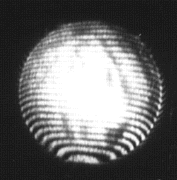Chapter 7 - Industrial Holography
(Sample page excerpted from book)

Holographic Interferometry: A Brief Overview of Current Applications and Technology
by Howard Fein
New methods of Non-Destructive analysis are becoming important and critical tools in the characterization of materials and sophisticated mechanical configurations. The unique properties of laser light have offered new ways for technologists to look at structures and materials, and physical phenomena and processes. Applied laser-based nondestructive test techniques can reveal significant and hitherto unachievable data concerning the actual dynamics and structure of a body under study. There is a virtually unlimited scope as new applications are discovered.
Primary among these technologies are methods of Holographic Interferometry. Derived from well known holographic imaging techniques, this analytical measurement ability has found widespread use in addressing a broad range of applications during the last thirty years.
There is a broad spectrum of applications for holographic methods covering virtually every aspect of static and dynamic structural analysis. This includes, but is not limited to applications
in Vibration and modal analysis; Structural analysis, composite materials and adhesive testing; stress and strain evaluation; and flow, volume, and thermal analysis.
The mechanisms of holographic Interferometry are well understood and various methods have been developed, but all are based on simple holographic optical configurations such as that illustrated in Figure 1. The methods of recording the holographic data vary: from silver halide photographic emulsion films and plates to advanced photopolymer plates, and even non-photographic CCD based “electronic” or “TV” holography. Photorefractive crystals are now being used to record and store multiple high volume holographic images and data as well.
Each of the recording methods is uniquely applicable to a range of analytical applications and the type of testing or data generation determines which would be most useful and efficient. Diffraction efficiency, contrast, resolution, and fringe precision are all considerations in the applicability and suitability of holographic Interferometry to any given analytical problem.
There are three basic methods of applied holographic Interferometry. Real Time, Multi-Exposure, and Time Average. The common element in all three cases is the laser which enables the production of holographic information. Interferometry nondestructive..
